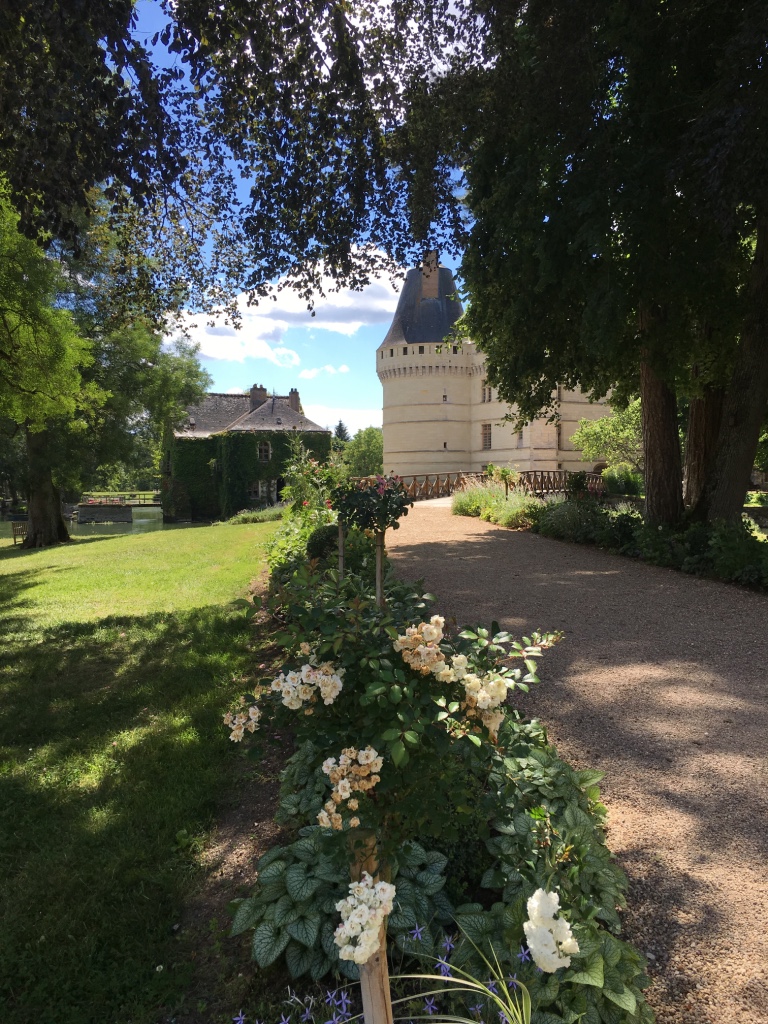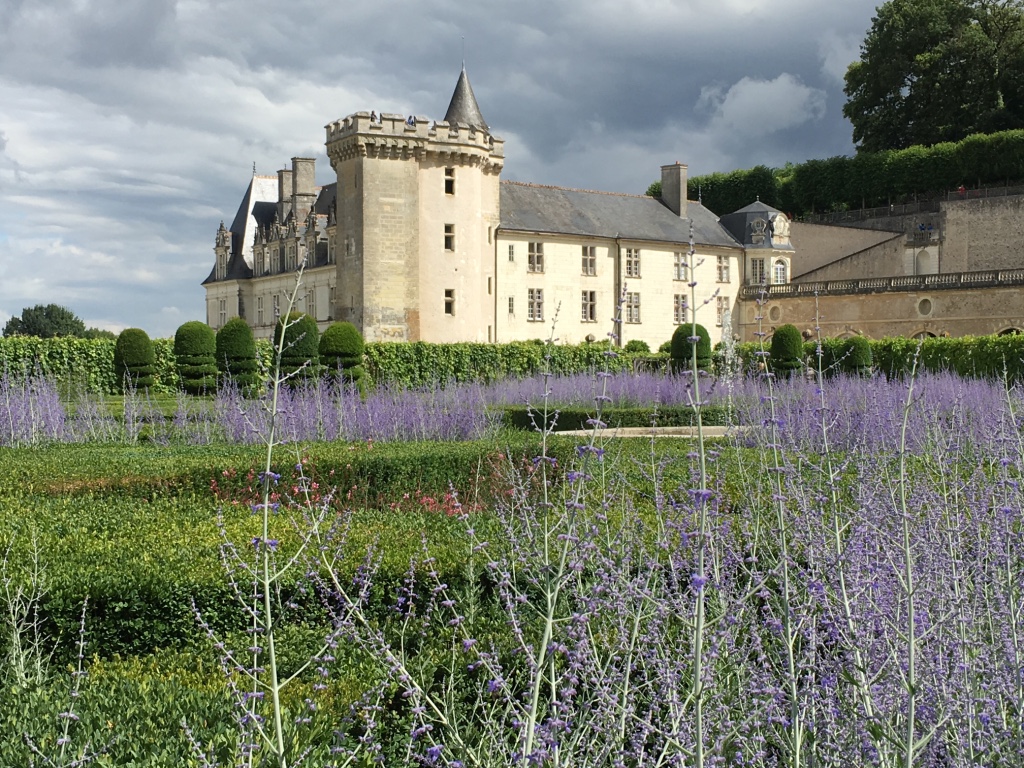I’m sitting in the circular stone remains of an old mill. Outside the mill race continues to gush, relentlessly. Water pouring over the lip and plunging two metres down into the pool below. This free fall of water provided the energy to turn the mill wheel and allowed the cogs to rotate and the mill stone to turn. Local people brought their wheat here and the Miller ground it for them into flour to bake their bread. Now a guest house the Old Mill is a great base for exploring the Loire and its exceptional collection of chateaux. I’m travelling with my daughter Lucy and our method of transport is the good old bicycle.
The Loire Valley is an area of fertile land, flowing water and sprawling forests. In the old days the French Kings and Queens came here to hunt, to enjoy La Chasse and to escape the gossip and intrigue of Paris. Francois Premier (Francis I) loved it here in the countryside. He based himself at the Royal Chateau of Amboise with its spectacular views over the river and surrounding countryside. Meanwhile he ordered the construction of Chambord – the biggest and most spectacular of the chateaux. Building work started in 1519.
Francois Premier loved art and culture, especially Italian art. He persuaded Leonardo da Vinci to come to Amboise and spend his final years thinking and inventing in the Chateau of Clos Luce – just up the road from his benefactor’s castle. In fact Leonardo is buried in the Chapel of St Hubert at Amboise. In a chapel dedicated to the hunt and the joy of La Chasse. Where King Francois went the French aristocrats followed and it wasn’t long before spectacular castles (chateaux) in the French Renaissance style sprung up along the length of the Loire and its tributaries.
Whilst Chambord is the biggest chateau, with more than 300 rooms, just 7 kilometres to the south-west is Villesavin one of the smallest. Villesavin is privately owned and open to the public in an attempt to generate revenue for much needed repairs. The house was built between 1527 and 1537 for Jean de Breton, friend, confidant and accountant of Francois Premier. He was also Chief of Works at Chambord and would ride through the forest to supervise construction of the mega-chateau at Chambord every few days. Villesavin is probably my favourite chateau, it is intimate and welcoming. The owners are trying to raise money to renovate the ‘Colombier’ a circular building with a conical roof – once occupied by hundreds of doves. They’ve developed a ‘ghost walk’ for kids in the park. There’s also a collection of wedding garments showing marriage fashions through the centuries. Many of the gowns are modelled on 1940s mannequins giving a surreal and rather sinister feel to the display. A large collection of elaborate mirrors is on display too. This is not a place you’d want to be accidentally stranded in when the last visitors leave for the evening.
A few miles to the west is the spectacular chateau of Chenonceaux, built like an elaborate medieval bridge across the River Cher. Originally this was the home of Diane de Poitiers favourite mistress of Henry II. On Henry’s death his wife Catherine of Medici, consumed by jealousy removed Diane from the chateau and took possession of Chenonceaux herself. To this day as you approach the chateau you have the Diane de Poitiers Garden to the east and the Catherine de Medici Garden to the west. Permanent reminders of the two women and their presence at this fairy-tale chateau.
The challenge nowadays is attracting visitors to your chateau. Some of the chateaux are owned by the French Republic, others are in private hands. One of the most successful is Cheverny, which opened its doors to the public in the 1920s. The Chateau was used by Herge as the model for the famous Marlinspike Hall in the Adventures of Tintin. The enterprising owners of the chateau have a Tintin Exhibit in their outbuildings and have attracted more than a million visitors in the last ten years. They also have a pack of hounds of mixed English-French descent who lead the Cheverny Hunt every season and have become a tourist attraction in their own right, with the daily ‘Soupe de Chien’ feeding of the hounds.
A little further west is the Chateau of Troussay – one of the smallest chateaux. It has an ‘English style Park Garden’ and is very much a family home. Parts of the chateau are open to the public and you can rent chambres d’hote (guest rooms) and stay in the chateau overnight. There’s an eclectic mix of vintage furniture in an adjoining barn, available to buy. As the only visitors on a fine sunny day in July we wonder how easy it is to make ends meet.
Just a short bike ride further west brings us to the Chateau Bourdaisiere, home of the ‘Prince Jardinier’ the gardening prince. This elegant chateau is a hotel and home to France’s Conservatoire de Tomate – the National Tomato Collection. The ‘Prince’ promotes himself vigorously as a horticulturalist and environmentalist. He has opened a permaculture farm at the chateau and has developed the tomato collection to include more than 600 varieties. He also owns the historic Deyrolle Shop in Paris – a legendary educational publisher specialising in the natural world and somewhat bizarrely taxidermy. The collection of stuffed animals is worth a look next time you are strolling down Boulevard St Germain. On the day of our visit the ‘Prince’ was nowhere to be seen, although a team of gardeners was hard at work. The chateau shop was open for business and a smart looking Tea Room was open too. The ‘Prince’s’ unique range of gardening tools, pots, garden furniture and gardening clothes are available to buy too. If you don’t mind paying € 80– for an apron!
Our destination this evening was Azay Le Rideau one of the prettiest chateaux built on the banks of the River Indre. The chateau appears to float on the waters that surround it. But the glory of Azay-le-Rideau is soon forgotten in comparison to the charm and joy of Chateau l’Islette just up the road. This is a family-owned small chateau that only opened its doors to the public in 2010. Famous as the ‘love nest’ of sculptor Rodin and his young pupil Camille Claudel. For anyone who loves Rodin and Claudel this chateau is a must. The owners move into a neighbouring property during the summer months and the chateau, including the family’s living rooms, kitchen and bedrooms are available for us, the general public, to enjoy. On our visit the owners, Pierre Andre Michaud and his wife Benedicte were welcoming visitors and actually gardening. The chateau itself is beautiful, with two rounded turrets, a river-side setting and a charming ivy covered mill right next door. You can rent a rowing boat for a little paddle on the river. Tables and chairs with brightly coloured cushions fill the terrace by the mill. When you buy your tickets at the entrance, children are invited to dress up in historic costumes, there’s a dressing up box and gowns hanging from a rail. There are even capes for adults. In the garden there are deck chairs and benches.
These are just a small selection of some of the chateaux available to visit in the Loire Valley. I’ll be writing about more in the weeks to come. Just a few hours drive south-west of Paris the Loire is a treasure trove of history, geography and architecture. Typically the chateaux are no more than 15 kilometers from one to the next, frequently less, so it really is the ideal destination for a cycling holiday. What could be better, cycling, historic visits and learning a bit about the famous ‘chateaux of the Loire’. The perfect holiday!
Notes:
- We stayed in Bracieux at Hotel Bon’Heure ideal for cycling to Chambord
- Later we moved to Le Vieux Moulin at Blere just outside Chenonceaux
- Lastly we stayed at Le Grand Monarque, Azay-le-Rideaux
- The most exquisite garden, for me, is at Villandry. Just magical.
- Happy to answer questions e-mail me here!



















Janet, when I read your beautiful, wonderful & very interesting little stories, I feel you take me on a little journey 🙂
Keep posting as I love to read- xx
LikeLiked by 1 person
Thank you Em – I love to share these tales……xxxxx
LikeLike
How absolutely divine. What a fabulous way to travel, on a bicycle. You get to see and experience everything and not miss a thing due to going too fast.
LikeLiked by 1 person
Another wonderful “Janet Adventure” told through excellent writing and beautiful photographs. Thank you so much, Janet!
LikeLike
Hi Janet, we are going to Amboise on our way back to UK from the Alps and spending 2 nights there as a base to explore some of the Loire, so thanks for this, very timely!
LikeLike